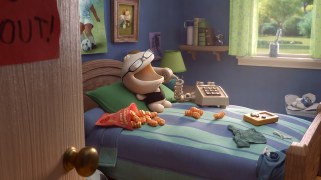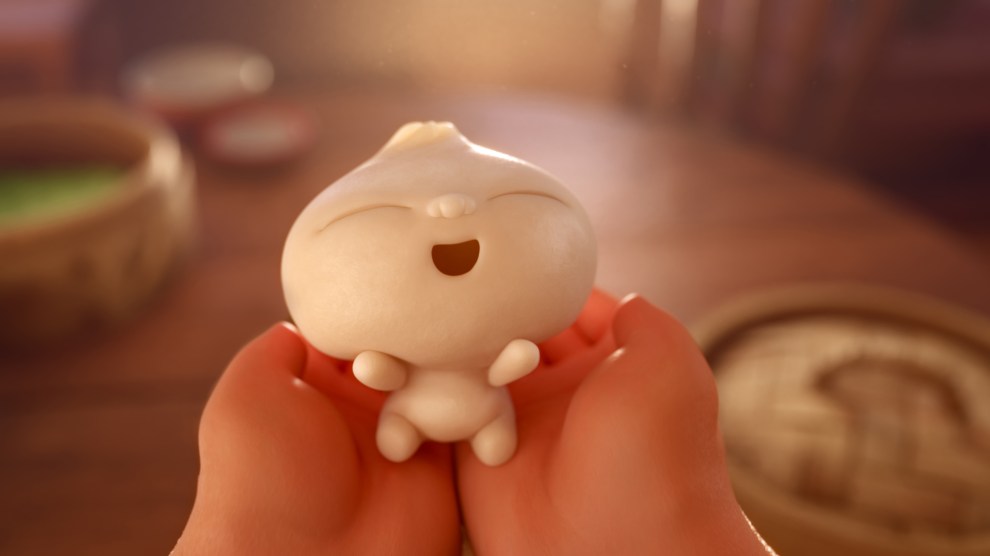Update (2/24/2019): Bao won!
If you haven’t seen Bao, one of this year’s Oscar contenders for best animated short film, you’re in for a treat.
Or not. In the film, the bao—which is a Chinese word for bun or dumpling—comes to life and grows up right before its mother’s eyes. But there’s a dark twist. After the Pixar short first screened for audiences at the theater to see Incredibles 2 in June, it received mixed responses from folks who were startled by the unexpected turn of events, and didn’t quite understand the story—or the culture behind it.
For the latest episode of the Bite podcast, I caught up with director Domee Shi at the Pixar Studios in Emeryville, California, to ask about her inspiration for Bao, and why she leaned into her experience as an Asian immigrant kid when crafting the fantastical tale.
Note: The following contains spoilers.
Mother Jones: How did you come up with the story of Bao?
Domee Shi: I’m an only child, and ever since I was little, my mom and my dad have treated me like their precious little dumpling. They’ve always coddled me, made sure I did all my homework, joined all the clubs; provided everything for me but also kept me really close. I wanted to explore that relationship and look at it from the point of view that I’m not as familiar with: the overprotective parent.
Food in general is also just a huge part of my family, of all Chinese families—it’s how we communicate with each other. It’s how my parents show their affection for me. They don’t say ‘I love you,’ but they’ll ask “Have you eaten yet? Eat more. You look too thin, or you look too fat.’ And I really wanted to just explore that food language of love…and my love of dark fairy tales, like the little gingerbread man. In many cultures, you see these fairy tales of people who get a chance at parenthood when they find a baby boy or a girl in a flower, bamboo shoot, or a peach, and I wanted to put a modern spin on that.
MJ: Speaking of dark fairy tales, there is—spoiler alert—a surprise twist. The doted-upon dumpling is eventually eaten by its mother. Why did you decide to go in that direction?
DS: That plot twist has always been in the story. That’s kind of what got me excited about making Bao. The personal inspiration behind that moment is from every time I visit my mom, she’ll hug me and say ‘Oh, Domee, I wish I could put you back in my stomach so I knew exactly where you were at all times.’ And I’m like, ‘Oh mom, that’s sweet—but creepy. Stop.’ I wanted to visualize that feeling of loving and obsessing over something so much that you’re heartbroken over it leaving you, and the only thing you can do to keep it close to you is to consume it.
MJ: So are the mother and father in Bao, your mother and father?
DS: They’re loosely inspired by my parents. The mom character is definitely my mother, but I see a lot of my other relatives in her, like my aunts and grandma, who are all very strong and independent. I see the dad character more as this symbol of a stoic, strong dad figure that I’ve seen a lot in my family, and in the families of a lot of my Asian friends. We exaggerated his personality a little bit—like he barely ever talks at all, and he’s mostly just watching TV. We wanted to show a different kind of parental love with his character and even though he’s not in most of the story, he comes in at a pivotal moment at the end. I see him as the silent bedrock of the family.
THIS 👏🏼 WASN’T 👏🏼 MADE 👏🏼 FOR 👏🏼YOU pic.twitter.com/cNDe1cDmAD
— William Yu (@its_willyu) June 25, 2018
MJ: Did you go into creating Bao knowing how specifically Asian-American (or Asian-Canadian) you wanted it to be?
DS: No. I’ve never directed a short at a big studio before, and I just assumed Pixar would want me to make the details more general, to try to appeal to a more “universal” audience. At one point, I was even shying away from the shocking ending because I was afraid people would be too upset by it. But I really owe it to Pete Docter, our executive producer and my mentor throughout this whole crazy process, he encouraged me to lean into those culturally specific details. Like, ‘Don’t be afraid to put yourself in the story because that’s what makes Pixar films special.’ He was also a huge fan of the twist ending. So having his buy-off on it, and also his support for it, really helped me stay focused and not afraid to make this short different.
MJ: Were you concerned about reinforcing any aesthetics, stereotypes, or caricatures associated with being an Asian immigrant, especially in America, knowing that this is a race-related dynamic we struggle with in this country?
DS: Totally. It was really important to me to depict our people right because there’s so few examples of it in Hollywood. So it was pivotal for me to get creative leadership on board that would approach the design and the look of the short with respect and attention to detail.
We picked Rona Liu as our production designer very early on. Even before I pitched it to Pixar, I was a fan of Rona’s work—plus, Rona is Chinese-American herself, and she was a huge help in not only creating the world of Bao, but also providing that really critical perspective to keep certain details in mind. She helped me explain to the crew why it’s important to have the drip pans on the stove be covered in tin foil (because that’s a practical way to keep your drip pans clean without having to wash them.) Or how sometimes families use toilet paper as general tissue around the house, so there’s a roll of toilet paper on the coffee table. Or why the dad character, even though he’s not smiling, isn’t a cold, distant, bad father or bad husband, he just shows his love more through little actions.
And even though Rona and I come from a Chinese background, we still did our homework—because we’re good, “A” students like that. We would take the crew on trips to San Francisco Chinatown and Oakland Chinatown. My family’s from Sichuan and a lot of the dishes in Bao are Sichuan-specific dishes that I really wanted to give a shout out to. So it was important for us to go to restaurants, take pictures of the food, and for me to explain the significance of each of the dishes to our crew.
MJ: You immigrated from China to Canada at a young age. Did that experience play out in Bao at all?
DS: Oh yeah. The generational difference between the mom character and the dumpling is kind of similar to my differences with my parents growing up because they live in a very homogenized Chinese society. All their friends are Chinese. They only listen to Chinese music. They only eat Chinese food. So when I was growing up, I like Chinese food, too, but I wanted to fit in. I wanted to eat Lunchables, PB and J sandwiches, chicken noodle soups, and stuff. My Western friends, their big brother or sister, or parents, would show them who The Beatles were or introduce them to Star Wars—my parents didn’t know that stuff.

In Bao, we show a little bit of that with how the bao character starts developing different interests. He plays soccer with his multicultural friends, he’s on the phone in his room, we came up with this little rap group that he’s into called “The Little Boys,” and he plays with his Gameboy—different things that the mom character just doesn’t know. Those details helped to show the divide between the two characters, but they’re reflective of real life, too, because that’s what a lot of immigrant kids went through. They’re caught between two worlds.
MJ: Were the interests that pulled bao away from his mom similar to yours?
DS: I was pretty much a good girl, a good Asian daughter—until after college. I always listened to my mom and dad, I never went out partying, I never tried alcohol. So I think I used the dumpling character as a way to vicariously live that life of being a rebellious immigrant teen. I wish I did all that stuff, but I was very much like that coddled dumpling that stayed by her mother’s side. I would rebel in non-rebellious ways. Like, you know how some parents would put Saran wrap over their remote controls to preserve the buttons? I would peel off the saran wrap and feel the buttons flush against my fingers.
MJ: How does it feel to be able to bring, not only your perspective, but the perspective of so many Asian-Americans or Asian immigrants into the spotlight in a meaningful way?
DS: It didn’t really hit me until we after we finished the short. Because when you’re making it, the weight of what it represents doesn’t quite hit you—you’re just focused on making it funny and touching and entertaining. But when we started showing it more outside of the studio, to different audiences, people came up to us afterwards crying and saying how they were so moved by how they finally felt seen by a big studio. It made me realize why this is really important, what we’re doing.
MJ: Tell me about your journey to becoming the first woman to direct a Pixar short. You’ve been here almost eight years and you started off as an intern.
DS: Drawing has been a passion of mine forever and I knew, even when I was little, that I wanted to draw for a living. I even considered exploring medical illustration because my parents wanted me to be a doctor. It was a good compromise, but it didn’t work out because I hate gore and blood.
It’s kind of cheesy but my biggest weakness in life ended up helping create my superpower. I’ve always been shy and introverted, and when I was in middle school I had a stutter which caused me to not say anything at all in a room. So I turned to drawing and I found that I didn’t have to say anything, but I could still communicate what I wanted through drawing. I worked hard at honing those really basic technical drawing skills. My dad’s a painter, an artist, himself, so he really helped me with that, too. We would go to life drawing classes together.
When I did my story internship at Pixar, I realized “oh, they actually want me to talk,” because a big part of being a storyboard artist is, you have to pitch your ideas in front of a large room of people. And it was terrifying at first. But I got here and I made a name for myself with my drawing abilities—and my ideas. Being that immigrant kid caught between two worlds, it turned into an advantage. In animation school and growing up, I’ve always loved Disney movies and Western animation, but I also love Japanese anime. Being at the center of these different cultures, I grabbed things that I liked from each of them and that helped me form my voice, my point of view, and my sense of humor, too. I was one of the few people in the story department that had that specific background and had more exposure to different stories, movies, and cartoons. That’s really helped me in my career.
MJ: So, has anything changed for you since the Oscar nomination?
DS: It’s funny because with all of the amazing press that Bao‘s been receiving, I’m also currently working on a feature film right now at Pixar. So it’s interesting jumping between the two. I am excited about Bao, at the same time I’m excited about this other thing that I can’t wait to show you guys, too.
MJ: Are you able to tell us anything about it?
DS: Unfortunately, not. But yeah, I’m so, so excited to go to the awards show. I’m human. I get excited when I see celebrities.


















